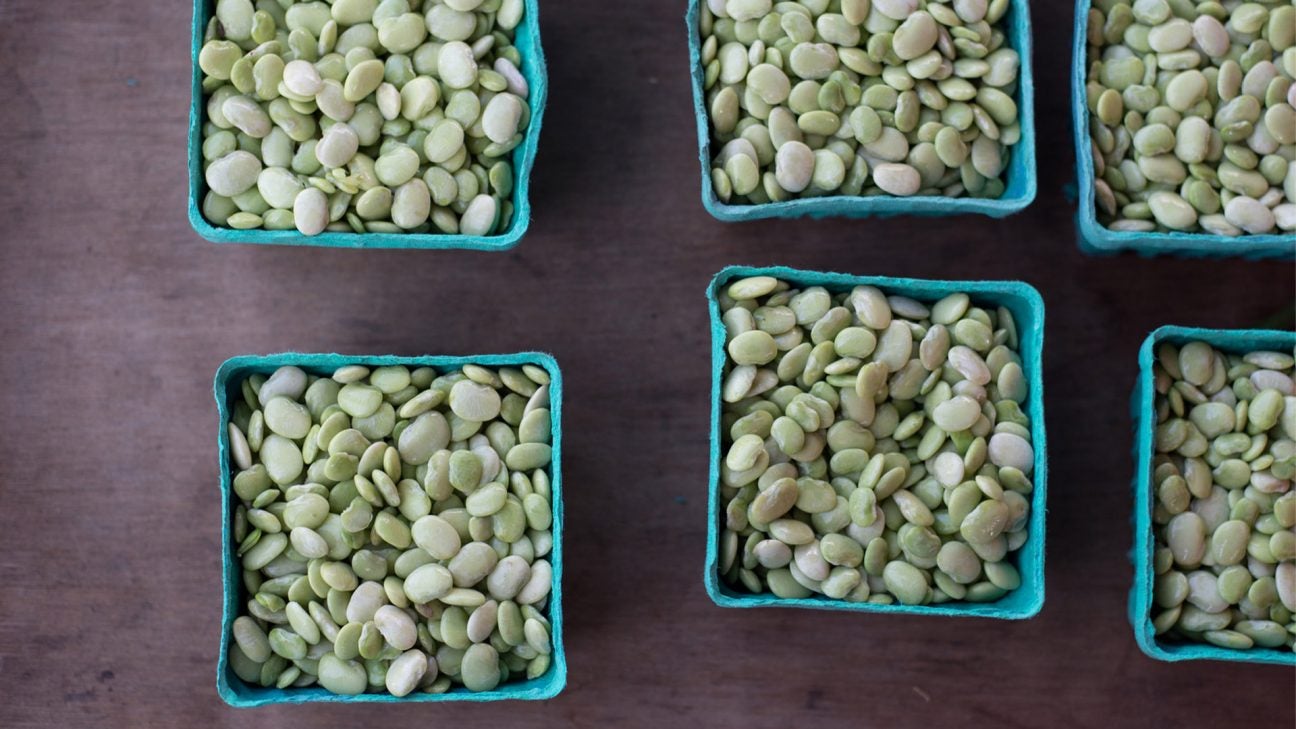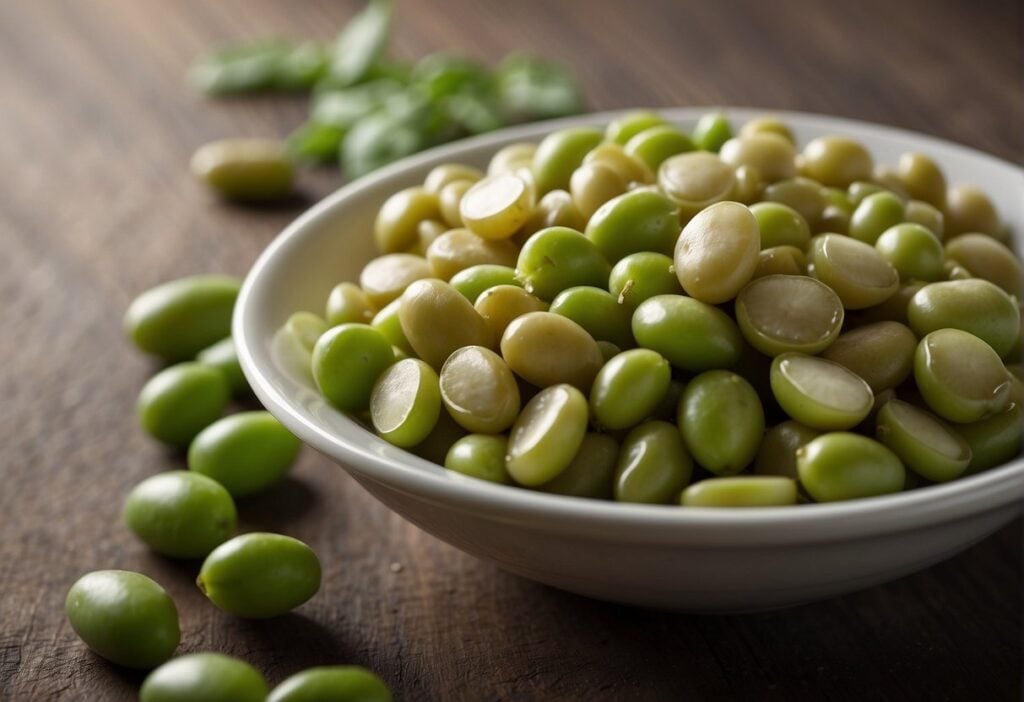Introduction To Lima Beans And Fava Beans

Lima beans and fava beans are two popular legumes that have been cultivated and consumed for centuries. Lima beans, also known as butter beans, are small, pale green beans that have a creamy texture and a slightly sweet taste. They are commonly used in soups, stews, and side dishes. On the other hand, fava beans, also called broad beans, are large, flat beans with a slightly nutty flavor. They are often used in Mediterranean and Middle Eastern cuisines. Both lima beans and fava beans are nutritious and versatile ingredients that can be incorporated into a variety of dishes.
Overview Of Lima Beans
Lima beans, also known as butter beans, are small, pale green legumes with a creamy texture and a slightly sweet taste. They are a popular ingredient in various cuisines around the world. Lima beans are rich in protein, fiber, and essential nutrients such as folate, manganese, and potassium. They are often used in soups, stews, and side dishes, adding a smooth and velvety texture to the dishes. Lima beans can be cooked in different ways, including boiling, steaming, or sautéing. Their mild flavor and versatility make them a great addition to any meal.
Overview Of Fava Beans
Fava beans, also known as broad beans, are large, flat legumes with a creamy texture and a delicate flavor. They have a distinctive earthy taste, similar to a combination of fresh peas and nuts. Fava beans are rich in protein, fiber, and essential nutrients such as iron, folate, and vitamin B6. They are commonly used in Mediterranean and Middle Eastern cuisines, where they are enjoyed in soups, salads, spreads, and stews. Fava beans have a slightly bitter outer skin that is often removed before cooking to enhance their taste and texture.
Nutritional Value And Health Benefits

Fava beans and Lima beans have impressive nutritional profiles and offer several health benefits. Fava beans are high in protein, fiber, and essential nutrients such as iron, folate, and vitamin B6. They also contain potassium and magnesium. Lima beans are rich in vitamins A, C, and K, as well as potassium and magnesium. Both beans are low in fat and calories, making them a healthy addition to a balanced diet. Additionally, their high fiber content helps regulate digestion and promote heart health. Consuming either bean can provide a boost of energy and support overall well-being.
Nutritional Content Of Lima Beans
Lima beans are packed with essential nutrients that contribute to overall health. They are rich in protein, fiber, iron, folate, and vitamin B6. Lima beans also provide potassium and magnesium, which are important for proper bodily functions. Additionally, they contain vitamins A and C, which have antioxidant properties and support immune health. With their low fat and calorie content, Lima beans are a nutritious addition to any balanced diet. Their high fiber content helps promote digestion and heart health. Incorporating Lima beans into your meals can provide an array of health benefits.
Nutritional Content Of Fava Beans
Fava beans are a nutrient-dense legume that offers an array of health benefits. They are an excellent source of protein, providing 26.12g per 100g serving, making them a great choice for vegetarians and vegans. Fava beans are also rich in potassium, with 1062mg per 100g serving, which helps maintain proper electrolyte balance and supports heart health. Additionally, they contain a high amount of dietary fiber, with 25g per 100g serving, promoting healthy digestion and aiding in weight management. Fava beans are also a good source of essential minerals and vitamins such as iron, folate, and vitamin K, contributing to overall well-being.
Cooking And Culinary Uses

Fava beans and lima beans offer a variety of cooking possibilities and are used in different culinary traditions. Fava beans are commonly used in Italian and North African cuisines. They can be boiled, fried, or pureed to create dishes like fava bean salads, soups, stews, and dips. Lima beans, on the other hand, are popular in South American and Caribbean cuisine. They are often used in stews, soups, casseroles, and as a side dish. Both beans can also be used in vegetarian and vegan dishes as a protein-rich substitute for meat.
Ways To Cook Lima Beans
Lima beans can be cooked in a variety of ways to enhance their flavor and texture. One popular method is boiling them until tender, which can be done on the stovetop or in a pressure cooker for faster results. Lima beans can also be added to stews, soups, and casseroles, providing a hearty and nutritious addition. For a different twist, they can be roasted in the oven until they become crispy, adding a delectable crunch to salads or as a standalone snack. Lima beans can even be pureed and used as a base for dips and spreads, offering a creamy and protein-rich alternative. Overall, Lima beans provide versatility in the kitchen, providing options for both traditional and creative recipes.
Ways To Cook Fava Beans
Fava beans can be prepared in various ways to bring out their unique flavor and creamy texture. One common method is boiling the beans until they become tender, which can take around 5-10 minutes. They can then be added to salads, roasted vegetables, or even mashed and spread on bread as a delicious topping. Another option is to sauté the beans with garlic and olive oil for a quick and flavorful side dish. Fava beans can also be pureed and used as a base for dips or incorporated into soups and stews for added richness. Their versatility allows for endless possibilities in the kitchen.
Taste And Texture

Fava beans have a unique taste and texture that sets them apart from Lima beans. They have a rich, nutty flavor with a subtle hint of bitterness. The texture of fava beans is velvety and creamy, making them perfect for purees and dips. On the other hand, Lima beans have a milder taste and a firmer texture. They are slightly starchy, giving them a hearty and dense mouthfeel. Lima beans work well in soups, stews, and casseroles, providing a satisfying texture to dishes. Overall, the taste and texture of these legumes offer a range of options for culinary creativity.
Taste Profile Of Lima Beans
Lima beans offer a mild and creamy taste that is often described as buttery. They have a subtle earthy flavor with a hint of sweetness. The texture of Lima beans is slightly starchy and dense, providing a satisfying bite. This makes them a versatile ingredient that can be enjoyed in a variety of dishes. Lima beans work well in soups, stews, casseroles, and salads. With their delicate taste and smooth texture, Lima beans add a delightful depth of flavor to any recipe.
Taste Profile Of Fava Beans
Fava beans offer a unique and distinctive taste profile. They have a nutty and earthy flavor with a hint of bitterness. Some people even describe the taste as slightly cheesy. Fava beans have a rich and creamy texture that becomes even creamier when cooked. Their flavor is complemented well by various seasonings and ingredients, making them a versatile ingredient in different cuisines. Fava beans can be used in soups, salads, dips, and spreads, adding a delightful depth of flavor to any dish. Their robust flavor pairs well with herbs, garlic, lemon, and olive oil, creating delicious and satisfying culinary creations.
Growing And Harvesting

Fava beans and Lima beans have different requirements when it comes to growing and harvesting.
Cultivating Lima beans involves planting them in well-drained soil with full sun exposure. They can be grown either as bush varieties or pole varieties that require support for their vines. Lima beans are typically ready to harvest around 70-90 days after planting, when the pods are plump and the beans inside are fully developed.
On the other hand, Fava beans thrive in cool climates and can tolerate some shade. They prefer rich, well-drained soil and are usually sown directly in the ground. Fava beans take approximately 90-110 days to mature and are harvested when the pods turn yellow or brown and the beans inside are tender.
Both beans can be easily harvested by carefully picking the pods from the plants. After harvesting, the beans should be shelled and can be stored for later use or cooked immediately for a delicious meal.
Cultivation Of Lima Beans
Lima beans are cultivated by planting them in well-drained soil with full sun exposure. They can be grown as either bush varieties or pole varieties that require support for their vines. It is important to ensure that the soil is rich in organic matter and has a pH level between 6 and 7. Lima beans should be spaced about 4-6 inches apart and sown at a depth of 1-2 inches. Adequate watering is necessary to keep the soil consistently moist but not waterlogged. With proper care and attention, Lima beans can be harvested around 70-90 days after planting when the pods are plump and the beans inside are fully developed.
Cultivation Of Fava Beans
Fava beans are relatively easy to cultivate. They prefer cool, temperate climates and well-drained soil. Fava beans can be sown directly in the garden in early spring, about 2 inches deep and 4-6 inches apart. They require regular watering, especially during dry spells, but excessive water should be avoided to prevent root rot. The plants should be supported with stakes or trellises as they can grow up to 5 feet tall. Fava beans are ready for harvest when the pods are plump and the beans inside are fully developed, usually around 80-100 days after planting.
Conclusion

In conclusion, both Lima beans and Fava beans are nutritious legumes that offer several health benefits. Lima beans are higher in protein and fiber content, making them a good choice for individuals looking to increase their satiety and support digestive health. On the other hand, Fava beans have a higher folate content and are packed with vitamin B6. The choice between the two depends on personal preferences and nutritional needs. Whether you choose to incorporate Lima beans or Fava beans into your diet, both can be used in a variety of delicious recipes to add flavor and texture to your meals.
Comparison Of Lima Beans And Fava Beans
Lima beans and fava beans are both nutritious legumes that offer various health benefits. However, they differ in terms of taste, texture, and nutritional content. Fava beans have an earthy, nutty flavor with a cheesy undertone, while lima beans have a milder, starchy taste. In terms of texture, fava beans have a slightly firmer and meatier texture compared to the softer and creamier texture of lima beans. Additionally, fava beans are higher in folate and vitamin B6, while lima beans are higher in protein and fiber content. Overall, the choice between the two depends on personal preferences and nutritional needs.
Popular Recipes Using Lima Beans And Fava Beans.
Lima beans and fava beans are versatile legumes that can be used in various delicious recipes. For Lima beans, a popular dish is Lima Bean Soup, which combines the beans with vegetables, broth, and spices for a hearty and comforting meal. Another favorite is Lima Bean Salad, where the beans are mixed with fresh vegetables, herbs, and a tangy dressing. As for fava beans, they are commonly used in dishes like Ful Medames, a traditional Egyptian stew, and Fava Bean Dip, a creamy and flavorful appetizer. Both beans can also be added to pasta dishes, stews, and vegetarian burgers for added protein and texture.
FAQ About Lima Beans Vs Fava Beans: Legume Showdown
Q: What are the main differences between Lima beans and Fava beans?
A: Lima beans are smaller in size compared to Fava beans. Fava beans have a buttery texture, while Lima beans are creamier. Additionally, Fava beans have a more distinct flavor compared to Lima beans.
Q: How do the nutritional profiles of Lima beans and Fava beans compare?
A: Both Lima beans and Fava beans are excellent sources of plant-based protein and fiber. Fava beans, however, contain higher levels of iron and manganese compared to Lima beans. Lima beans are richer in folate content.
Q: Can Lima beans and Fava beans be used interchangeably in recipes?
A: While Lima beans and Fava beans can be used interchangeably in some recipes, it’s essential to consider the differences in taste and texture. Fava beans are more robust in flavor and may overpower dishes where a milder taste is desired.
Q: Are there any culinary tips for cooking with Lima beans and Fava beans?
A: Lima beans benefit from gentle cooking methods to preserve their creamy texture, while Fava beans often need to be shelled and blanched before use. Fava beans can also be roasted for a nuttier flavor.
Q: How do Lima beans and Fava beans contribute to a healthy diet?
A: Both Lima beans and Fava beans are nutrient-dense legumes that provide essential vitamins, minerals, and antioxidants. Incorporating them into a balanced diet can help support heart health, digestion, and overall well-being.

Salsas by Karoll’s Catering is a vibrant and innovative Canadian fusion family restaurant that welcomes you to indulge in a delightful culinary experience. Every Sunday, from 11 am to 2 pm, we invite you for a delicious brunch that will tantalize your taste buds. Whether you prefer dining in or taking out, we ensure that our delectable dishes are available to savour at your convenience. In addition to our enticing Sunday brunch, we host a lively happy hour every Thursday, Friday, and Saturday. During this time, you can enjoy discounted food items, get $2.50 off on beer, and sip on refreshing $5 margaritas. It’s the perfect opportunity to unwind and relish in the flavours of our Canadian fusion cuisine.